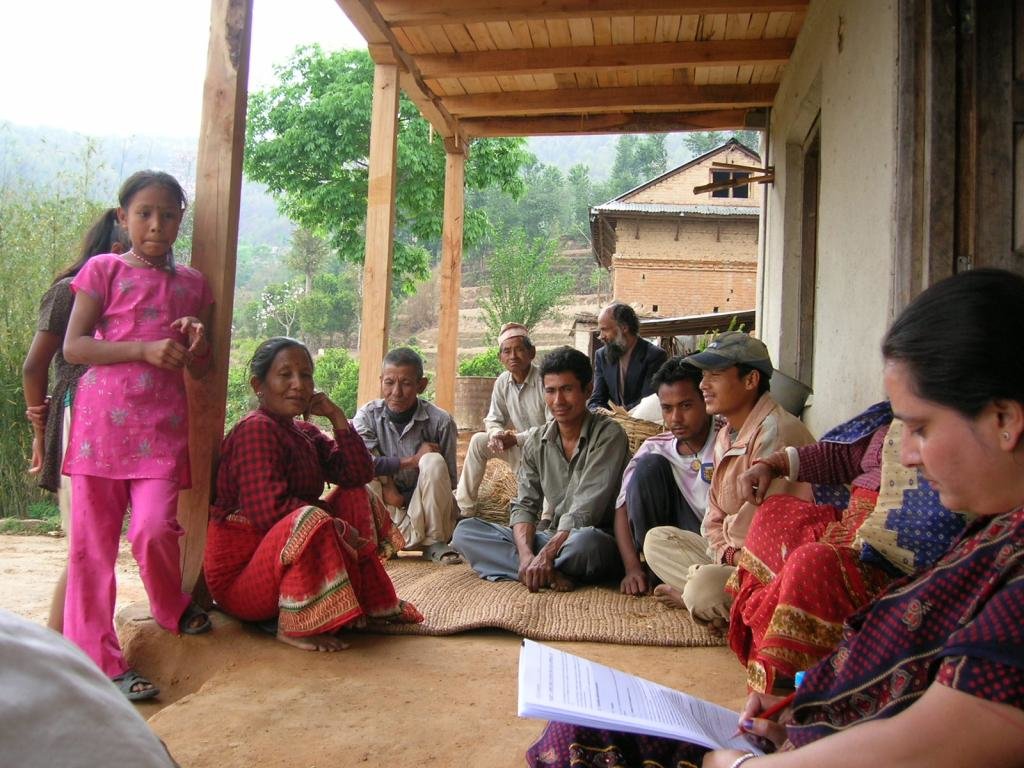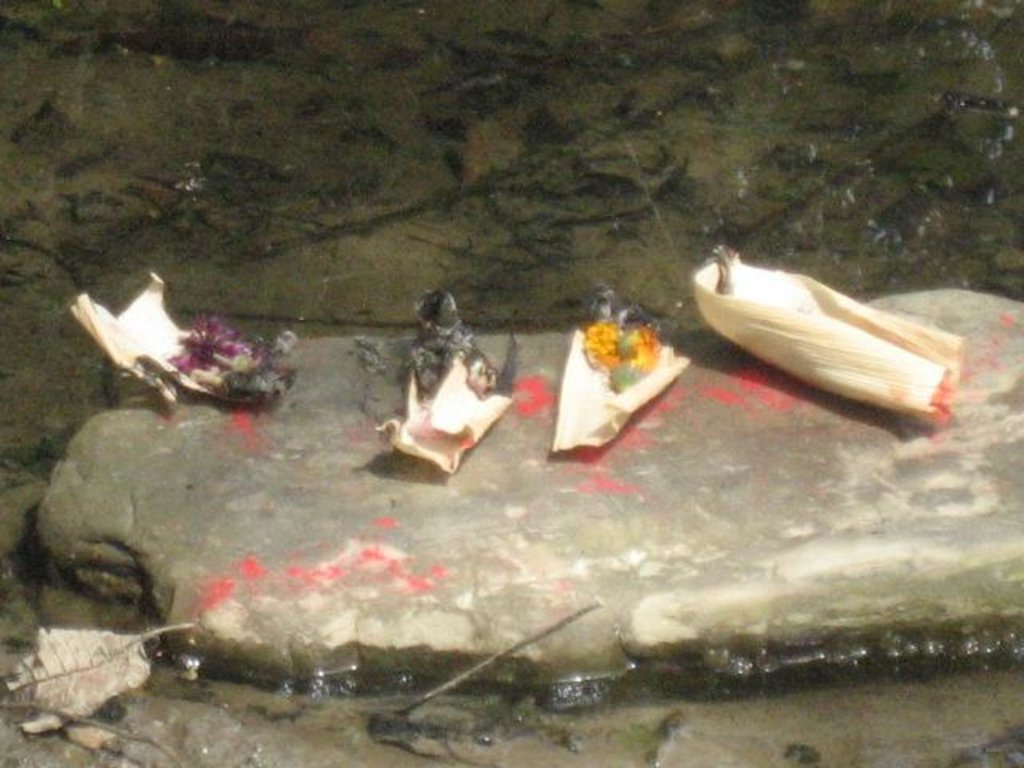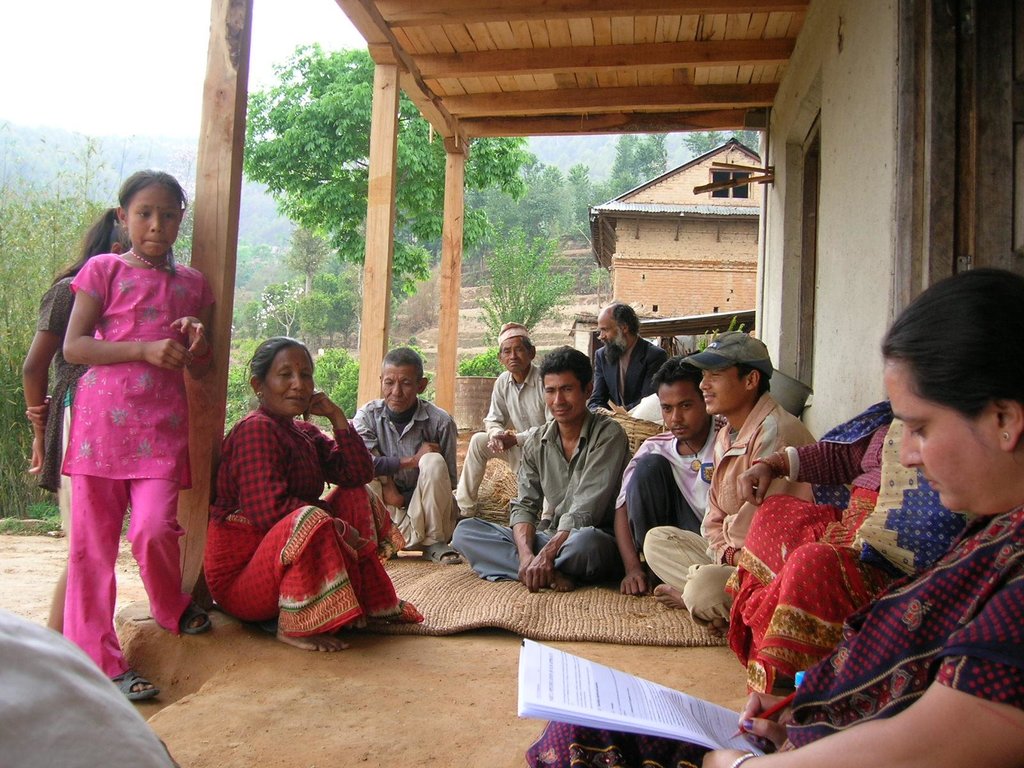Trans-generational approach for the protection of gully [Népal]
- Création :
- Mise à jour :
- Compilateur : Sabita Aryal
- Rédacteur : –
- Examinateur : Fabian Ottiger
Samudaik Kholsa Sanrakshan
approaches_2669 - Népal
Voir les sections
Développer tout Réduire tout1. Informations générales
1.2 Coordonnées des personnes-ressources et des institutions impliquées dans l'évaluation et la documentation de l'Approche
Nom du ou des institutions qui ont facilité la documentation/ l'évaluation de l'Approche (si pertinent)
Kathmandu University (KU) - NépalNom du ou des institutions qui ont facilité la documentation/ l'évaluation de l'Approche (si pertinent)
Sarada Batase Village Development Committee (Sarada Batase VDC) - Népal1.3 Conditions relatives à l'utilisation par WOCAT des données documentées
Le compilateur et la(les) personne(s) ressource(s) acceptent les conditions relatives à l'utilisation par WOCAT des données documentées:
Oui
2. Description de l'Approche de GDT
2.1 Courte description de l'Approche
The gully protection activities were initiationed and maintained by local people by using local materials based on their indigenous knowledge which supports to achieve more sustainable soil and water management.
2.2 Description détaillée de l'Approche
Description détaillée de l'Approche:
Aims / objectives: The aim of the approach is to reduce gully formation, protect the fertile agricultural land and minimise the effect of slipping down of the village.
Methods: Individual farm ownner along the side of the gully take the first responsibility of the maintannce. The Jagidol village community and the Newari Guthi of the region, and all Hindus who worship for the Nagdevata and Shiva devata along the stream bank take extra care and consiousness on gully protection. It is a collective efforts through social networks.
Stages of implementation: Ever on going. Basically individual initiation. If the problem is bigger in Community gathering and discussion takes place for planning of necessary activities. Material will be collected locally. Hands of implementation is called from the local area. This approach has been continued for over 200 years.
Role of stakeholders: The land wonner along the stream bank have major role, if the situation becomes terrific then only other give hands. Men are more active for the land protection during crisis such as flood, but in regular upkeeping and maintainance women are more active.
Other important information: Gully is much more in control in the upper region where the bioengeenering approache is applied; there it is more stable and mature. In the lower belt of the gullies it still is under the need of regular maintanace.
2.3 Photos de l'approche
2.5 Pays/ région/ lieux où l'Approche a été appliquée
Pays:
Népal
Région/ Etat/ Province:
Nepal
Autres spécifications du lieu :
Kavre
2.7 Type d'Approche
- traditionnel/ autochtone
2.8 Principaux objectifs de l'Approche
The Approach focused mainly on other activities than SLM (Activities of religious, cultural and biological importance)
To protect agains gully formation. To protect under the soil loss. To protect the land from flood. Protection of source of water for dry season. To prevent landslides. To prevent the slidding of the hill towards the gully. To improve the well being of the farm and farmer.
The SLM Approach addressed the following problems: Lack of institutional development. The group is not registered anywhere in a conservation team or organisation. Thus getting no technical and financial support from government or non-governmental organisations. The research done by the community is not documented, it is trasmitted by mouth to mouth. To manage the gully labour shortage in the village is a rwal constraint.
2.9 Conditions favorisant ou entravant la mise en œuvre de la(des) Technologie(s) appliquée(s) sous l'Approche
normes et valeurs sociales/ culturelles/ religieuses
- entrave
situation of the temple nearby the gully and worship place for 'Nag devta'( snake God)
Treatment through the SLM Approach: mutual discussion and decision
disponibilité/ accès aux ressources et services financiers
- entrave
to buy implementation tools
Treatment through the SLM Approach: use of local material, call for kind donations within the community and if possible, cash from the community
cadre institutionnel
- entrave
no linking of the act with the organisation
Treatment through the SLM Approach: self management
cadre juridique (régime foncier, droits d'utilisation des terres et de l'eau)
- favorise
The existing land ownership, land use rights / water rights greatly helped the approach implementation: The land in the gully side is owned by individual farmers. The water resource available next to the farm is also used by the individual farmer. Thus the managing of the gully, stopping further erosion etc. is also in responsibility of the owners. If a problem increases at a certain site of an individual farmer, this means his land will be more affected than others, he takes the initiative for getting help from availabe sources of the village community
- entrave
land owner is the most responsible
Treatment through the SLM Approach: the land owner is convined by other villagers to maintain the gully near by his plot
connaissances sur la GDT, accès aux supports techniques
- entrave
no complete awarness of the conservation acts but continued as it is transmitted from generation to generation
Treatment through the SLM Approach: new methods and material are used by learning from other program or project implemented in the neighbourhood areas
charge de travail, disponibilité de la main-d'œuvre
- entrave
During the busy parts of the farming calendar there is little or no labour available for SLM projects.
Treatment through the SLM Approach: SLM projects are scheduled so that they coincide with periods of less farm labour stress, i.e. dry season.
autre
- entrave
Conservation measures generate more time during the busy farming period of monsoon
Treatment through the SLM Approach: extra hands will be called from the community
3. Participation et rôles des parties prenantes impliquées dans l'Approche
3.1 Parties prenantes impliquées dans l'Approche et rôles
- exploitants locaux des terres / communautés locales
The people who own the land near by the stream and the village as a whole. The land owners and elderly persons of the village
It is considered as a heavy work and therefore carried out by young men. Men are involved during the problem time. Women are regularly involved all around the year for the maintanance.
- gouvernement national (planificateurs, décideurs)
- organisation internationale
- near by villager or practitioner
Si plusieurs parties prenantes sont impliquées, indiquez l'organisme chef de file ou l'institution responsable:
The old man and women in community take initiative to explain best methdos.Young men on the basis of their observation around the other similar problem and solution choose the option and implement. Women member maintain the gully during the farming time.
3.2 Participation des exploitants locaux des terres/ communautés locales aux différentes phases de l'Approche
| Participation des exploitants locaux des terres/ communautés locales | Spécifiez qui était impliqué et décrivez les activités | |
|---|---|---|
| initiation/ motivation | auto-mobilisation | The villagers realised that they needed to protect the land to increase the amount of available farming land and to protect their village from landslides. |
| planification | auto-mobilisation | The villagers plan various counter measures during the dry season, so that when the monsoon come their land would be protected |
| mise en œuvre | auto-mobilisation | The land users implemented the protective measures using local materials . |
| suivi/ évaluation | auto-mobilisation | The build protective measure are maintained and repaired from time to time. |
| Research | aucun | no documentaion is made besides our study |
3.4 Prises de décision pour la sélection de la Technologie/ des Technologies
Indiquez qui a décidé de la sélection de la Technologie/ des Technologies à mettre en œuvre:
- les exploitants des terres seuls (auto-initiative)
Expliquez:
The land users have been implementing these technologies since many years. They have developed their own methods and selection of technology and material by trial and error. They have used intuitive reasoning for excellence.
Decisions on the method of implementing the SLM Technology were made by by land users* alone (self-initiative / bottom-up). by observing the best resulting methods and material. By learning from the nearby places where the technology is selected under the guidance of conservation specialists.
4. Soutien technique, renforcement des capacités et gestion des connaissances
4.1 Renforcement des capacités/ formation
Une formation a-t-elle été dispensée aux exploitants des terres/ autres parties prenantes?
Oui
Formats de la formation:
- sur le tas
- entre agriculteurs (d'exploitants à exploitants)
4.3 Renforcement des institutions (développement organisationnel)
Des institutions ont elles été mises en place ou renforcées par le biais de l'Approche?
- non
4.4 Suivi et évaluation
Le suivi et l'évaluation font ils partie de l'Approche? :
Oui
Commentaires:
bio-physical aspects were regular monitored by land users through observations; indicators: No formal reporting was ever made, but evolution of the approach were continually observerd.
technical aspects were regular monitored by land users through observations; indicators: No formal reporting was ever made, but evolution of the approach were continually observerd.
Continuity of the approach aspects were regular monitored by land users through observations; indicators: No formal reporting was ever made, but evolution of the appraoch were continually observerd.
There were few changes in the Approach as a result of monitoring and evaluation: The insecurity factor of the land user is combined with religious aspects such as the development of temple
There were few changes in the Technology as a result of monitoring and evaluation: New and recent material and technology is emerging in the lower area were the practice is relatively young
5. Financement et soutien matériel externe
5.1 Budget annuel de la composante GDT de l'Approche
Si le budget annuel précis n'est pas connu, indiquez une fourchette:
- < 2 000
Commentez (par ex. principales sources de financement/ principaux bailleurs de fonds):
Approach costs were met by the following donors: local community / land user(s) (There has been no external aid): 100.0%
5.2 Soutiens financiers/ matériels fournis aux exploitants des terres
Les exploitants des terres ont-ils reçu un soutien financier/ matériel pour la mise en œuvre de la Technologie/ des Technologies?
Non
5.3 Subventions pour des intrants spécifiques (incluant la main d'œuvre)
- aucun
Si la main d'œuvre fournie par les exploitants des terres était un intrant substantiel, elle était:
- volontaire
Commentaires:
Full costs to land users
5.4 Crédits
Des crédits ont-ils été alloués à travers l'Approche pour les activités de GDT?
Non
6. Analyses d'impact et conclusions
6.1 Impacts de l'Approche
Est-ce que l'Approche a aidé les exploitants des terres à mettre en œuvre et entretenir les Technologies de GDT?
- Non
- Oui, un peu
- Oui, modérément
- Oui, beaucoup
Land slide and food shortages are reduced, soil loss is prevented. The sliding of the hill and community habitation is improving.
Est-ce que l'Approche a autonomisé les groupes socialement et économiquement défavorisés?
- Non
- Oui, un peu
- Oui, modérément
- Oui, beaucoup
Est-ce que l'Approche a amélioré les questions foncières et des droits d'utilisation qui entravent la mise en œuvre des Technologies?
- Non
- Oui, un peu
- Oui, modérément
- Oui, beaucoup
Community action will be not taken unless the individual farmer takes his initiative to solve the problem. Since it is individual farm it is thought to be managed by the land owner particularly
Did other land users / projects adopt the Approach?
- Non
- Oui, un peu
- Oui, modérément
- Oui, beaucoup
Other farmers from neighbouring valleys have seen the SLM measures implemented in the gully and have adopted them in their own region.
Did the Approach lead to improved livelihoods / human well-being?
- Non
- Oui, un peu
- Oui, modérément
- Oui, beaucoup
With increase in water ans soil conservation, there is provided increased arable land for quality crop production, thus also improves health and well being in the valley
Did the Approach help to alleviate poverty?
- Non
- Oui, un peu
- Oui, modérément
- Oui, beaucoup
The production of the farm is now sufficient for more months then it was before. As a whole the village has benefited from the approach increasing the wealth of the village.
6.2 Principale motivation des exploitants des terres pour mettre en œuvre la GDT
- augmenter la production
Creating better soil conditions and water management for irrigation
- augmenter la rentabilité/ bénéfice, rapport coûts-bénéfices
With more farmland and water for irrigation more profits can be obtained.
- conscience environnementale
When the farmers cleared too much land they realised that they needed to implement SLM measures
- well-being and livelihoods improvement
With better drinking water the community's well-being improved.
- Risk minimisation
The risk of flooding and runoff of farm and soil, landslide is major threat to them.
6.3 Durabilité des activités de l'Approche
Les exploitants des terres peuvent-ils poursuivre ce qui a été mis en œuvre par le biais de l'Approche (sans soutien extérieur)?
- incertain
Si non ou incertain, spécifiez et commentez:
The approach needs subsidies or external support to sustain it due to shortage of local labor volunteers. With funding support the village can purchase better materials to create longer lasting structures.
6.4 Points forts/ avantages de l'Approche
| Points forts/ avantages/ possibilités du point de vue de l'exploitant des terres |
|---|
| Remarks and suggestion of nearby land users and community persons are taken into serious consideration (How to sustain/ enhance this strength: Learning of society to respect and regard others suggestion. Morale value) |
| Points forts/ avantages/ possibilités du point de vue du compilateur ou d'une autre personne ressource clé |
|---|
| Community network and individual farm ownership, self farming by land owner, most of the landowner reside at the same hill (How to sustain/ enhance this strength: Discourage migration of farming community to nearby city) |
6.5 Faiblesses/ inconvénients de l'Approche et moyens de les surmonter
| Faiblesses/ inconvénients/ risques du point de vue de l’exploitant des terres | Comment peuvent-ils être surmontés? |
|---|---|
| Migration of farmer for better job. Commencement of new owner. Comming of a brick making factory instead of farming. | Government should give more rules for cultivable land. |
| Faiblesses/ inconvénients/ risques du point de vue du compilateur ou d'une autre personne ressource clé | Comment peuvent-ils être surmontés? |
|---|---|
| No proper and formal planning. No connection with authority and funding organisations | Formalisation of the group for conservation practices |
7. Références et liens
7.1 Méthodes/ sources d'information
- visites de terrain, enquêtes sur le terrain
- interviews/entretiens avec les exploitants des terres
Liens et modules
Développer tout Réduire toutLiens
Aucun lien
Modules
Aucun module trouvé





